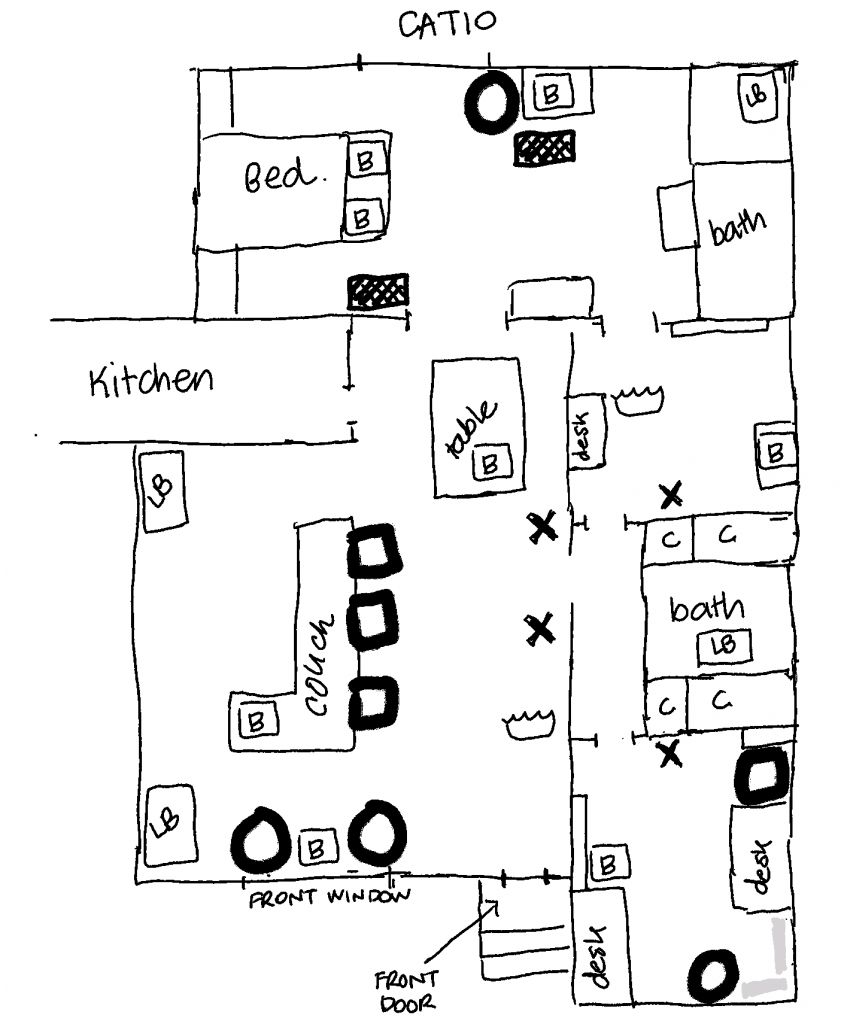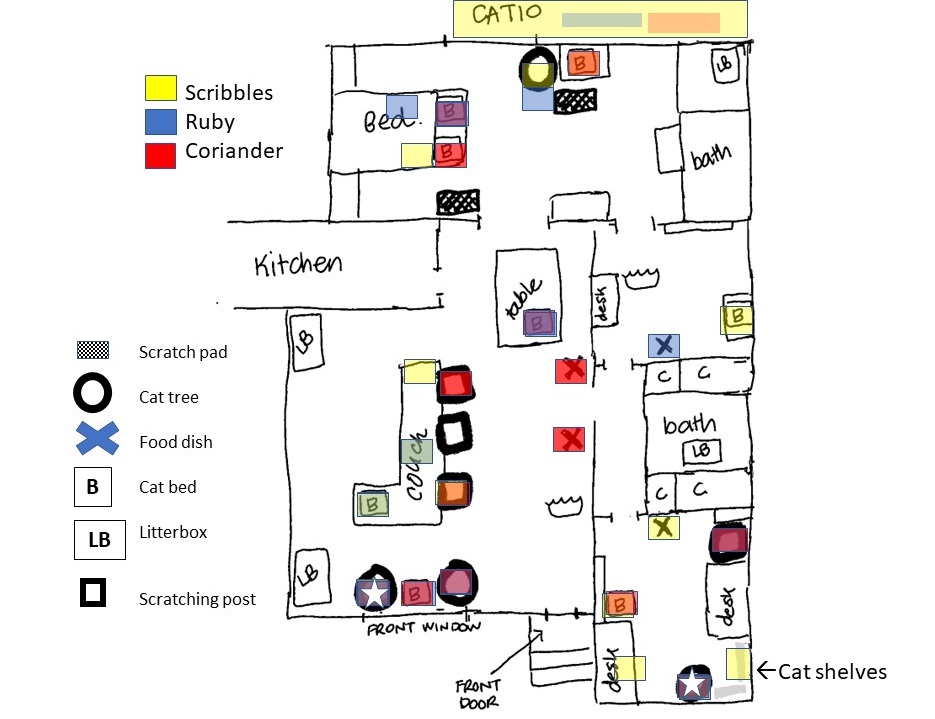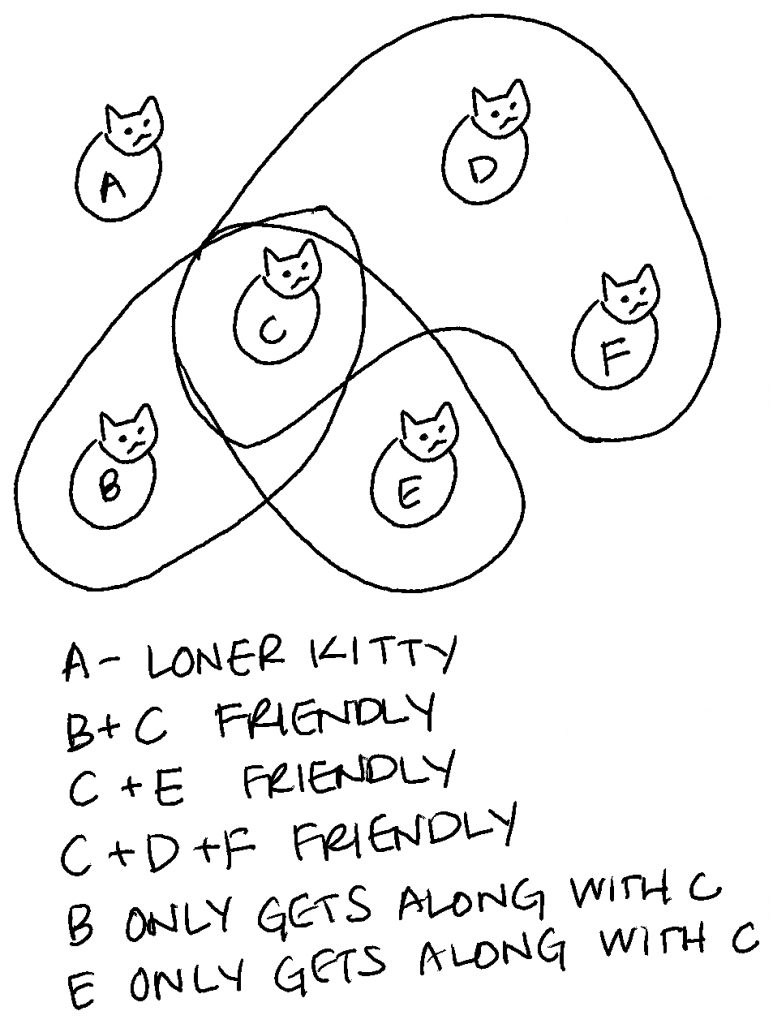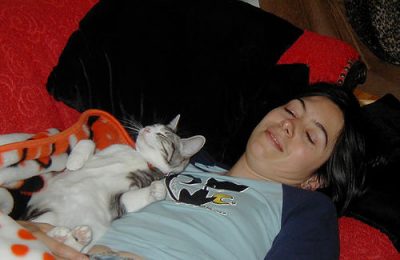In this third post about how cats use space, we are now going to take a hyper-focused look at not just how you lay out the resources for cats in your home but how they get used! This is especially helpful for multi-cat households, but if you’ve only got one kitty, you may want to try it – and let me know if it was useful!
First lets review: We know that cats who live indoors will establish both a core territory and a home range, just like kitties who go outside. The core territory is an area they will protect, while the home range is the space they patrol, investigate, and otherwise use with regularity. In my last blog post, I discussed the importance of multiple and separated key resources, which allow cats to share space and minimize stress and conflict.
Hopefully you already drew a map (like I did) with all of your cat resources (food dishes, litter boxes, cat trees, scratching posts, etc.) labeled, like so:

Now, take a moment to think about which cat use which resources. What resources are shared and which are used exclusively by one cat? Are any of your “cat things” rarely, if ever, used?
Which spaces are time-shared (say, one cat uses in the morning, and another cat uses in the afternoon) and which are shared simultaneously (hopefully by cats who like one another!)?
If you have behavior issues within your household (such as litter box avoidance or fighting/conflict) it can also be helpful to note those on your map. I have three cats and I color coded the areas that each cat uses with red (Coriander), blue (Ruby) or yellow (Scribbles). When Coriander and Ruby share a space, the area now appears to be purple, and if Ruby and Scribbles share a space, it appears green, and if Coriander and Scribbles share a space, it appears orange.
I also put stars in areas that all 3 cats use which were: all four litter boxes, one cat tree in our living room, and one cat tree in our office.

What was apparent was that Scribbles has the most “exclusive” territory, and although she has spaces she shares with both Ruby and Coriander, they seem a little bit more laid back and likely to share than she is. She also spends the most time in the catio, and her favorite cat tree is the one that looks out over the catio, which neither Coriander or Ruby ever sleep or sit on (Ruby does scratch the base of that cat tree). Aside from Scribbles being rather comfortable in the back area of the house, I could not carve out any specific cat core territories, so it appears that my cats all overlap their territories quite a bit (also my house is pretty small!).
The three of them are also more likely to time share than spend time on the same piece of furniture, although all three cats sleep on the bed with us at night and sit on or near the couch with us when we watch TV in the evening.
I adopted three sisters, and although I would say they all get along without conflict, they don’t show frequent signs of feline friendship, such as:
- Laying together, touching
- Grooming each other
- Playing together
- Nose touching
They do all these things, just not very often. They may spend time in the same room together, but they are more likely to time share than use a resource together. I would characterize their relationship in the sister-roommate zone – closer than just roommates, but not quite “preferred associates” or friends.
As you create your annotated map, ask yourself the following questions:
- Do my cats share or time-share?
- Do my cats have distinct and separate core territories?
- Do some cats have shared territories?
- If so, can they access all the important resources they need within their own core territory without going into other cats’ exclusive core territories (if necessary)?
- Are there passageways that can be blocked by cats or disrupted by people?
- Is there so much stuff in your home that your cats can’t keep an eye on each other?
- Are your cats forced to share some resources because there’s not enough to go around (the general rule of thumb is the number of cats + 1 for key resources like litter boxes, feeding areas, scratching posts, etc.).

This is also a good opportunity to look at whether your cats are roommates, friends, or likely not friendly. Keep in mind that if you have a large feline household, you can have several different “families” of cats, and some cats that get along with everyone and some cats that get along with no one! You can map out relationships just like you map out your home. Which cats share territory, and show signs of friendship?
In this example, kitty C gets along with 4 out of 5 other cats; kitty A wishes she lived alone, and while C, D, and F form a social group, cats B and E only like cat C.
I really like this video by Cats Protection that can help you tease apart whether your cats are friendly or not!
I recommend updating your house map and social map regularly to note how things might be changing – even with the seasons (sun spots moving), or as you get new “cat stuff” or as your household composition changes – so might your cats’ use of space and relationships!!
Let me know what you find when you work through these exercises!



One thought on “How do cats use space? Part 3: Looking at relationships”